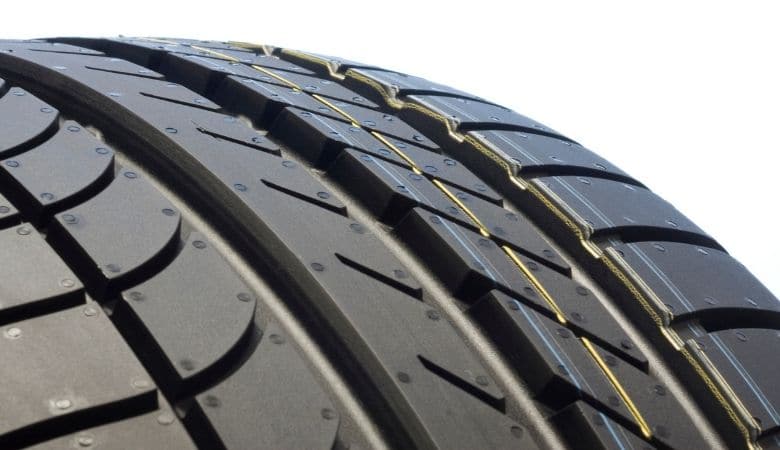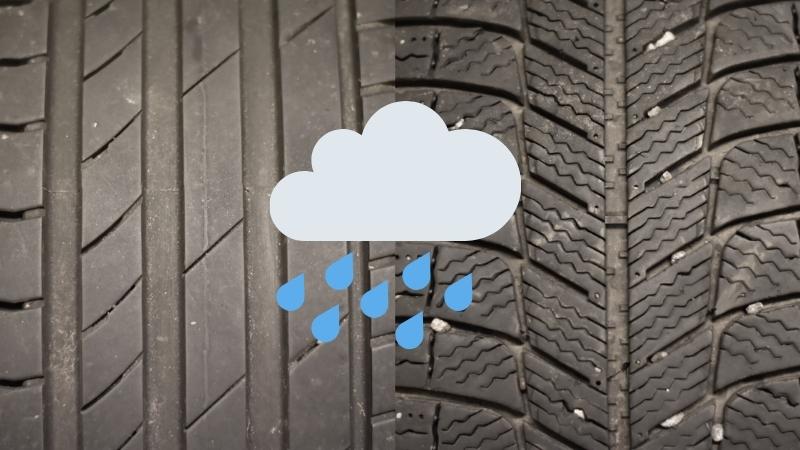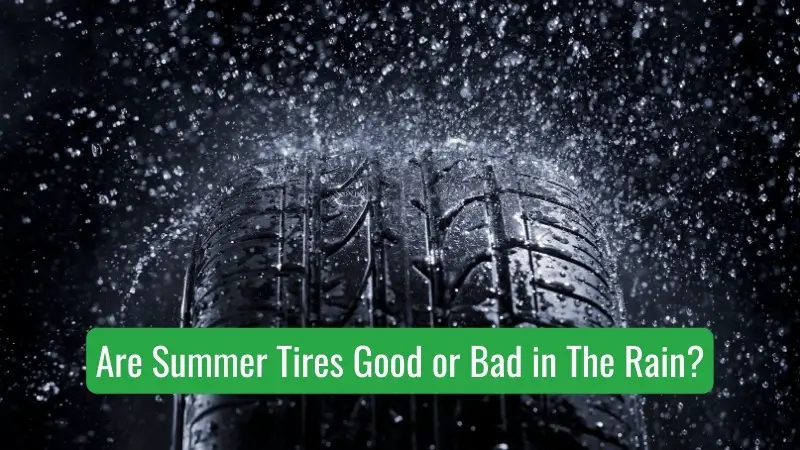When it comes to driving in the rain, the right choice of tires can significantly impact your safety and performance on the road.
Your main concern might be whether summer tires are good or bad for this type of weather.
Knowing the differences between various tire types and their suitability for wet conditions is essential for making an informed decision.
Summer tires, as the name suggests, are designed for warmer climates and can provide optimal grip in the rain when made from the right rubber and tread patterns.
Their tread area is specifically optimized for excellent road grip, making them suitable for driving on both dry and damp surfaces. However, it’s important to keep in mind that summer tires should be replaced when the temperature drops below 45-degrees Fahrenheit, as their performance may decline in colder conditions.
While summer tires can work well in rainy weather, it’s critical to consider the specific weather conditions in your region before committing to a set.
Comparing the performance of summer tires to all-season tires may help you determine which type is best suited for your needs in various weather scenarios, including rainy conditions.
Ultimately, understanding the capabilities and limitations of summer tires can ensure that you stay safe and in control while driving in wet weather.
What Are Summer Tires

Summer tires, also known as performance tires, are designed to provide optimal grip and handling during the warm season. These tires feature a unique tread pattern and rubber compound that give your car improved performance on both dry and wet surfaces during summer months.
Unlike all-season or winter tires, summer tires are specifically engineered for high-performance driving in warmer weather conditions.
The rubber compound used in summer tires is softer and stickier than that found in all-season tires. This attribute allows these tires to maintain better contact with the road, ensuring increased traction and responsiveness.
Additionally, their tread pattern is less aggressive, with fewer grooves and channels compared to winter or all-season tires. This design choice results in a larger contact patch for improved handling and grip on dry surfaces.
Another characteristic of summer tires is their increased rigidity. The sidewalls of these tires are stiffer, which not only helps to improve handling but also provides better stability during high-speed cornering.
This feature makes them a popular choice for performance cars and driving enthusiasts. However, it’s important to note that summer tires are not suitable for use in cold temperatures or in snowy and icy conditions, as their performance significantly decreases under such circumstances.
In summary, summer tires offer enhanced performance, handling, and grip in warm weather conditions. Their specialized rubber compound, tread pattern, and rigidity set them apart from all-season and winter tires.
Remember to switch to appropriate tires when the temperature drops or when facing snowy and icy conditions to ensure your safety and your vehicle’s performance.
Summer Tires Performance in Wet Conditions
When considering summer tires for wet driving conditions, it’s essential to understand their performance characteristics. Let’s discuss three critical factors: tread pattern, hydroplaning resistance, and wet braking.
Tread Pattern
Summer tires have a unique tread pattern that provides excellent dry handling on hot asphalt and road conditions.
They usually have larger tread blocks and fewer grooves, which can help with traction during wet weather.
Their specialized tread design helps channel water away from the contact patch, giving you better grip and handling on wet roads.
Hydroplaning Resistance
One of the main advantages of summer tires in wet conditions is their ability to resist hydroplaning.
When driving at highway speeds, summer tires are better at preventing hydroplaning than all-season tires due to their specialized design.
Ensuring that your summer tires have adequate tread depth and proper inflation can significantly reduce the chances of hydroplaning, keeping you safe on the road.
Wet Braking
Wet braking performance is another crucial factor to consider when assessing summer tires in wet conditions.
While they may not always outperform all-season tires in wet braking, their unique construction and tread design can still offer impressive stopping power.
However, it’s worth noting that wet braking distances can differ significantly between various tire models, so it’s essential to choose a summer tire specifically designed for wet weather performance.
In conclusion, summer tires can perform well in wet conditions, but it’s essential to invest in a tire specifically designed for wet weather performance.
By considering factors such as tread pattern, hydroplaning resistance, and wet braking, you can make an informed decision on the right summer tire for your needs.
Comparing Summer Tires to Other Tire Types in Wet Conditions

As stated earlier, summer tires are engineered to provide excellent grip, handling, and responsiveness on both dry and wet roads.
However, it’s essential to compare them to other types of tires, such as all-season and winter tires, to understand their performance in wet conditions.
Summer Tires
Summer tires feature a unique tread pattern and rubber compound that provide excellent grip and traction in wet conditions. The tread design typically has wide grooves and channels that help disperse water efficiently, reducing the risk of hydroplaning.
The rubber compound remains soft and flexible in warm temperatures, allowing the tires to maintain better road contact, enhancing overall wet grip performance.
However, summer tires are not suitable for cold temperatures or snow, as their performance drastically decreases in such conditions.
All-Season Tires
All-season tires are designed to perform well in various weather conditions, including wet roads. They have a balanced tread pattern and rubber compound that can handle both dry and wet surfaces.
However, their performance in wet conditions may not be as good as summer tires, as their tread design and compound are meant to compromise between warm and cold temperatures.
All-season tires provide decent wet grip performance but may not match the exceptional handling and responsiveness of summer tires.
Winter Tires
Winter tires, also known as snow tires, are designed specifically for cold temperatures and snowy or icy road conditions. Their tread pattern is optimized for snow and ice, with many sipes and biting edges for improved traction.
The rubber compound in winter tires remains soft and flexible even in freezing temperatures. However, when it comes to wet conditions, winter tires generally do not perform as well as summer or all-season tires.
The primary focus of winter tires is to provide grip on snow and ice, so their performance on wet roads may be subpar compared to the other two types of tires.
In conclusion, when it comes to driving in wet conditions, summer tires outperform both all-season and winter tires, providing excellent grip, handling, and responsiveness.
However, it’s essential to remember that summer tires are not suitable for cold temperatures or snowy conditions, and you should switch to appropriate tires for those conditions.
Safety Tips for Driving in the Rain
Driving in the rain can be a challenging experience, but with the right precautions, you can ensure a safer journey.
Here are some essential safety tips for driving in wet conditions with summer tires:
- Maintain Proper Tire Inflation: Check your tire pressure regularly and make sure they are inflated according to the manufacturer’s recommendations. Under-inflated or over-inflated tires can affect your vehicle’s handling and traction in wet conditions.
- Inspect Tread Depth: Monitor the tread depth of your summer tires to ensure they provide adequate grip on wet surfaces. Worn-out tires with shallow treads can increase the risk of hydroplaning. Replace your tires if they reach the minimum tread depth recommended by the manufacturer.
- Slow Down: Reduce your speed when driving in the rain to minimize the risk of hydroplaning and improve overall vehicle control. Wet roads require longer stopping distances, so drive cautiously and maintain a safe following distance from the vehicle in front of you.
- Avoid Sudden Movements: Make gentle and gradual steering, acceleration, and braking inputs to maintain better control over your vehicle. Abrupt maneuvers can cause your tires to lose traction, increasing the risk of skidding or hydroplaning.
- Use Headlights: Turn on your headlights when driving in the rain to improve visibility and help other drivers see your vehicle. Avoid using high beams, as they can create glare and reduce visibility for oncoming drivers.
- Keep a Safe Distance from Large Vehicles: Stay at a safe distance from large vehicles like trucks and buses, as they can spray water onto your windshield, reducing visibility. Be cautious when overtaking or being overtaken by large vehicles in wet conditions.
- Avoid Puddles and Standing Water: Try to avoid driving through large puddles or areas with standing water, as they can cause your vehicle to hydroplane. If you must drive through a puddle, do so slowly and maintain a firm grip on the steering wheel.
- Use Your Vehicle’s Safety Features: Make use of your vehicle’s safety features, such as anti-lock braking systems (ABS), electronic stability control (ESC), and traction control, to enhance your control over the vehicle in wet conditions.
- Plan Your Route: Plan your route in advance, taking into consideration the weather conditions and potential traffic issues. Avoid areas prone to flooding or poor drainage, if possible.
- Stay Alert and Focused: Pay close attention to your surroundings, road conditions, and other drivers. Minimize distractions, such as mobile devices or loud music, to stay focused on the road.
By following these safety tips, you can reduce the risks associated with driving in the rain and enjoy a safer driving experience.
Always remember to adapt your driving style to the prevailing weather conditions and be prepared to adjust your plans if necessary.
Hi, my name is Niklas, the head content creator & CEO of Whirling Wheelz. I am very interested in vehicles of all kinds, mainly cars. I have a car mechanics degree from high school and a big hobby of mine is to follow the WRC (World Rally Championship) both online and through travel.


